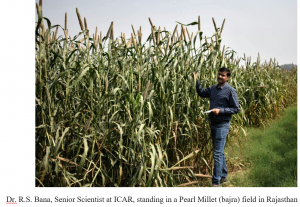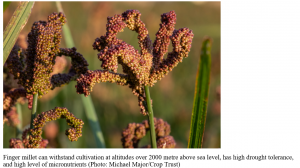Nutritious Must-Have Millets
A detailed look at nutri-cereals that offer food and nutritional security.
Millets are marvellous sources of nutrition. Traditional and rural societies everywhere in the country and agricultural scientists in the top echelons of the Indian government have long known it. But it took free India 70 years to notify millets as “Nutri-Cereals”— in 2018 — which was also nationally declared as “The Year of Millets”.
agricultural scientists in the top echelons of the Indian government have long known it. But it took free India 70 years to notify millets as “Nutri-Cereals”— in 2018 — which was also nationally declared as “The Year of Millets”.
According to a note prepared by the Union Agriculture Ministry, “Millets can help tackle health challenges such as obesity, diabetes and lifestyle problems as they are gluten-free, have a low glycemic index and are high in dietary fibre and antioxidants.” The note further states that “millets are nutritionally superior to wheat and rice owing to their higher levels of protein with a more balanced amino acid profile, crude fibre and minerals, such as iron, zinc, and phosphorous.”
Curative Power
A Mysuru-based scientist, Dr Khader Valli, popularly known as the “Millet Man of India”, explains why millets are superior to rice and wheat. How our body processes food is important to the absorption and value of food:
“Any food that takes a longer time to break down the glucose and fructose to be absorbed by the blood is truly healthy. While rice takes only 45 minutes to be absorbed by the blood, positive grains or millets take six hours”, says Dr Valli.
A post-doctoral fellow of Environment Science at Beaverton, Oregon, Dr. Valli did his PhD on steroids at the Indian Institute of Science, Bengaluru. But that was a long time ago. For the last 35 years, since he quit a lucrative job in the U.S., Dr. Valli has dedicated himself to the promotion of millets. He swears by their therapeutic value and prescribes a mix of five millets to his patients. Called the Siridhanya (rich grains) diet plan, it includes Kodo, Barnyard, Foxtail, Brown Top and Little Millets, and is reported to have cured patients suffering from a host of diseases, including anaemia, infertility, diabetes and cancer. Dr. Valli says, Barnyard millet, known as Udalu in Kannada and jhangora in Hindi, is his “personal favourite”.
Also Read : Aahaar Kranti and India’s Struggle with Malnutrition
Popular Dishes
In south India, Barnyard Millet flour is popularly used for making local foods like idli and dosa. In the north, especially in Uttarakhand, it is mixed with milk and sugar/jaggery to make a sweet dish, madira ki kheer and with buttermilk known as paleu. Mixed millets khichdi is also popular in many parts of India while millet cookies, puffs, flakes and laddus are fancied items at high-end organic food stores all over the country. Research studies confirm the high nutrition of millets in general and Barnyard Millet in particular.
A 2019 research paper by V. G. Ranganathan and others of the Tamil Nadu Agriculture University, Madurai, titled “Barnyard Millet for Food and Nutritional Security: Current Status and Future Research”, published in Frontiers in Genetic Nutrigenomics, June 23, 2020, says: “The nutritive value of Barnyard Millet is superior to that of other major and minor millets. It is a rich source of calcium, protein, magnesium, fat, vitamins, and some essential amino acids.”
According to the paper, the average carbohydrate content of Barnyard Millet varies between 51.5 and 62.9/100 grams, which is lower than that of other millets; its fibre, ranging between 8.1% and 16.3%, is higher than in any other cereal and the protein content, between 11.2% and 12.7%, is reasonably higher than in other millets and cereals. “The high ratio of carbohydrates to crude fibre ensures the slower release of sugar in the blood, aiding in maintaining blood sugar levels.”
Recognising their nutritional value, the agriculture ministry recommended the inclusion of millets in the Public Distribution System (PDS) for improving nutritional support, but the idea has not caught on. Only Karnataka, Odisha and Uttarakhand have introduced millets in PDS, the main problems being the low shelf life of millets and poor storage facilities. For the same reasons, millets have not been included in mid-day meal schemes, among the most important places for the implementation of the government’s plan for millets.
Food as Status Symbol
While the government is still struggling against bottlenecks, private businesses are retailing millets successfully. Not just whole millets and millet flour, but also ready-to-eat items made out of them, are in high demand at upmarket food stores, which many find “unusual”. “Initially, I was surprised to find foreigners and high-profile Indians asking for items made out of such desi things as ragi and jhangora that I thought were rather crude,” says saleswoman Meenakshi at one such store. “But now I know better,” she adds. Experts understand why she thought poorly of millets.
According to Senior Scientist at the Indian Council of Agriculture Research (ICAR) – Indian Agriculture Research Institute, Delhi, Dr. R S Bana, the young population of traditional and tribal societies have an “inferiority complex” about millets, and need to be educated about their nutritional value. They perceive rice and wheat as superior foods, he says, an observation that is endorsed by researchers. However, the scene has changed over the last decade.
Coarse Vs Refined
Lifestyle diseases like diabetes, hypertension, and cancer, sourced to the preference for chemically processed and fast foods over the whole and coarse ones, have made the wealthy review their dietary choices. Refined and polished foods are being blacklisted by them and crude foods with good roughage are the order of the day.
Dr. Bana agrees that there is a sizeable section of the rich and educated that is lately quite sensitive to the value of millets. It is they who offer the best hope of promoting millets. “Once they adopt these cereals as a staple diet, the approach of the poor people would also change.” As of now, Dr. Bana says, poor people are eating these nutritious foods “by default”.
Also Read : Dr Harsh Vardhan announces launch of `Aahaar Kranti’
POSHAN Atlas
A document, “The Current Position of Millets”, prepared by the Union Agriculture Ministry, talks about ways to  promote the consumption and production of millets. Interestingly, it refers to a millet recipe book in regional languages published by The Indian Institute of Millets Research (IIMR).
promote the consumption and production of millets. Interestingly, it refers to a millet recipe book in regional languages published by The Indian Institute of Millets Research (IIMR).
As if to underline the importance of millets in the Prime Minister’s Overarching Scheme for Holistic Nutrition (POSHAN), a “POSHAN Atlas” is being prepared under the guidance of the Principal Scientific Advisor; the atlas has information on state-specific recipes that account for cultural food preferences and palates. The Food Safety and Standards Authority of India (FSSAI) has designed and is running the “Eat Right India Initiative”, which, the ministry paper says, could be an avenue for pushing for a wider use of millets.
The flip-flop over millets—from being known as the poor man’s food to being projected as a health food—also makes one wonder about the origin and composition of millets. According to a research paper by P. Ashoka and others, (published in November, 2020 in The International Journal of Current Microbiology and Applied Sciences), millets originated in and around India, and have been the staple diet and health guardians of traditional societies for centuries. Belonging to the Poaceae/Graminae family, they are small-seeded grasses, yielding two major millets (Sorghum and bajra) and six minor millets (Finger, Foxtail, Little, Proso, Kodo, and Barnyard millets). Recently, a few minor millets have been added to this group, like Fonio, Quinoa and Brown Top millet.
“Each of the millets”, the paper notes, “is three to five times nutritionally superior to the widely promoted rice and wheat in terms of proteins, minerals (calcium and iron), and vitamins and fibre.” Millets, it adds, “are an ideal food for all the people, irrespective of age, and especially beneficial for children, pregnant and lactating women who are prone to anaemia.”
Local to Global
Today, India is the number one producer and consumer of millets in the world with Rajasthan as the top producer of millets in the country followed by Karnataka.The most interesting part of the millet graph is that in March this year, the United Nations declared 2023 as “The International Year of Millets”. The resolution in the U.N. General Assembly was proposed by India, and the Union Agriculture Ministry is already busy planning its campaign.
With so much energy being injected into the campaign, it would be no surprise if millets, described as “the first crops” in a government book, “The Story of Millets”, turn out to be “the future crops”— not just in India but across the globe. (India Science Wire)
